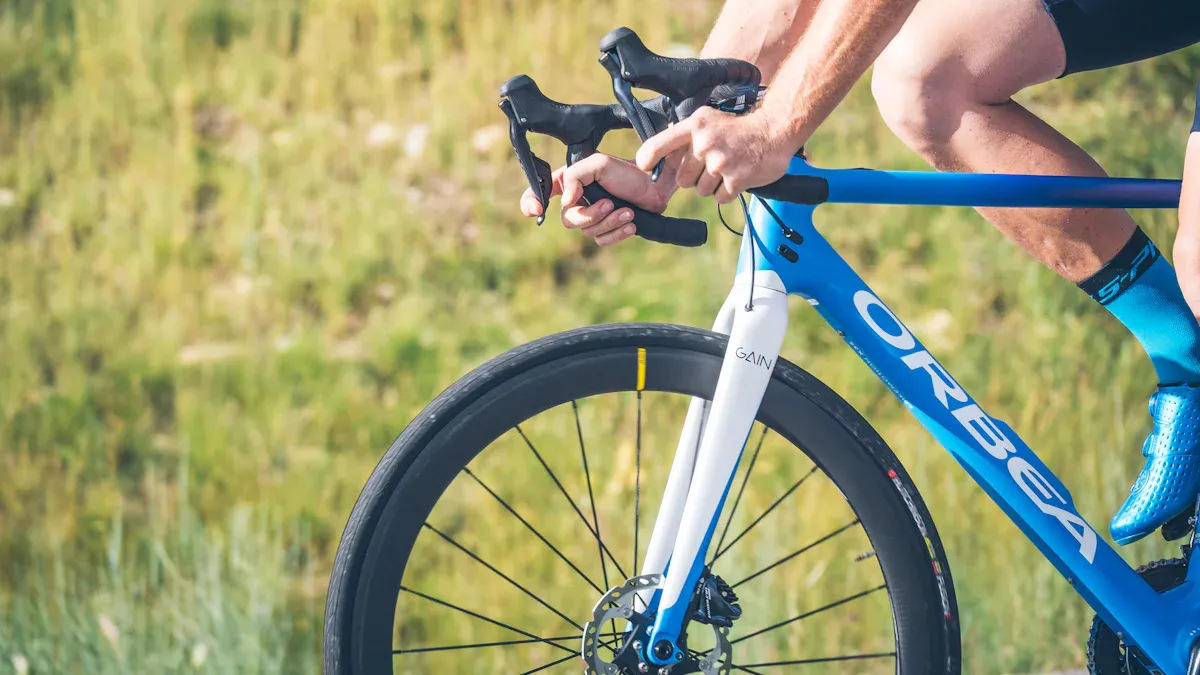
A road bike frame is comfortable and fast when many things are balanced. Materials like aluminum, steel, and carbon fiber change how the bike feels and works. Geometry changes how you sit and affects comfort or speed. Aerodynamics help cut through air and make you go faster. Stiffness and compliance change how power moves and how bumps feel. Fit makes sure the bike matches your body.
Factor | Impact on Performance and Rider Satisfaction |
|---|---|
Material | Aluminum: cheap, light; Steel: strong, smooth ride; Carbon fiber: very light, soaks up bumps |
Geometry | Aggressive: less wind slows you, less comfy; Upright: more comfy, but more wind slows you |
Aerodynamics | Cuts down wind, helps you go faster |
Stiffness/Compliance | Changes how the bike feels and how comfy it is |
Fit | Changes how comfy you are and how well you cut wind |
Key Takeaways
Picking the right frame material changes how comfy and light your bike is. Aluminum is light and does not cost much. Carbon fiber is also light and gives a smooth ride. Steel makes the ride feel soft and comfy. Titanium is strong and comfy at the same time.
Frame geometry decides how you sit and ride your bike. A relaxed geometry makes long rides more comfy. An aggressive geometry helps you go faster but may feel less comfy.
Aerodynamic frame shapes help you ride faster by cutting wind. These shapes can make the bike less comfy for some people. They can also make the bike harder to control.
Getting a good bike fit is very important. Changing saddle height, handlebar spot, and cleats stops pain. It helps you pedal better and makes riding more fun.
Wider tires and good vibration absorption make rides smoother. This helps you feel less tired and lets you ride longer with less pain.
Road Bike Frame Materials
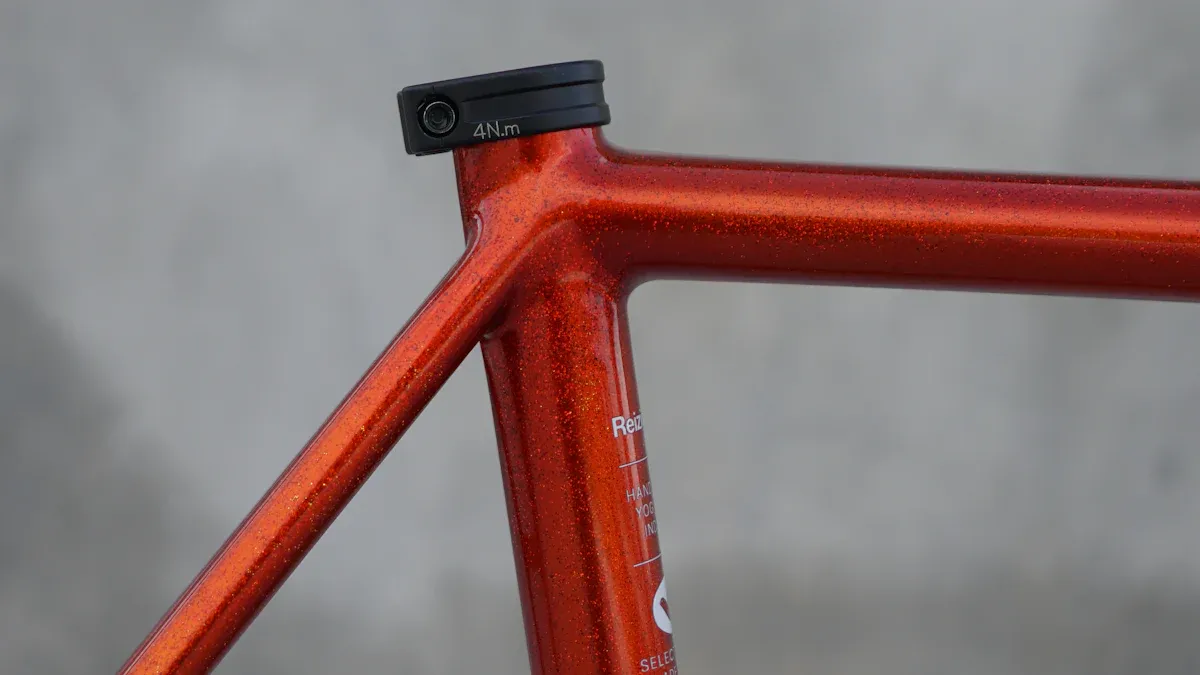
Picking the right material for a road bike frame changes how it feels and rides. Each material has its own special features. Riders think about weight, stiffness, comfort, and how long it lasts when they choose a frame.
Material | Market Share (2024) | Key Characteristics and Market Insights |
|---|---|---|
Aluminum | Lightweight, durable, cost-effective, largest market share, accessible to many consumers | |
Carbon Fiber | N/A (growing fastest) | High growth potential due to technological advances, lighter and stronger frames, increasing demand |
Steel | Smaller share | Durable, compliant ride quality, heavier than aluminum and carbon fiber |
Titanium | Smaller share | Durable and lightweight but niche market |
Aluminum
Aluminum is the most common material for road bike frames. It is light and stiff, so many riders like it. Newer aluminum frames use special shaping to make them more comfy and stiff where needed. Aluminum frames are tough and not too expensive, which is why so many people buy them.
Tests show aluminum frames are heavier than carbon fiber but lighter than steel. Aluminum is very stiff, so it does not bend much when you push hard. This helps you use your power well, but the ride can feel rough on bumpy roads. Riders often feel more shaking with aluminum than with other materials.
Aluminum frames can last 5 to 10 years if you take care of them. Some last even longer if you ride a lot. Checking for cracks and keeping the frame clean helps it last.
Tip: If you want a good price, light weight, and strong frame, aluminum is a smart first choice.
Carbon Fiber
Carbon fiber is the fastest-growing material for road bike frames. Riders who want the lightest and most high-tech frames pick carbon fiber. Makers can shape carbon fiber in many ways, so frames can be stiff and comfy at the same time.
Carbon fiber frames weigh less than aluminum and steel. They soak up more bumps, so rides feel smoother and less tiring. Carbon fiber is also very stiff when you pedal or turn, so the bike reacts fast.
Frame Material | Weight | Stiffness | Comfort |
|---|---|---|---|
Aluminum | Generally heavier than carbon but can be competitively light with good components; tends to be stiffer and can feel harsher than steel; improved with hydroforming for tailored stiffness and comfort | ||
Carbon Fiber | Lightest due to superior strength-to-weight ratio; engineered for directional stiffness and compliance; offers superior damping and torsional stiffness leading to better comfort and responsiveness | ||
Steel | Heavier than aluminum; more compliant and comfortable but less stiff | ||
Titanium | Weight between steel and aluminum; very comfortable and durable |
You need to be careful with carbon fiber frames. They can break suddenly if there are hidden cracks or if bolts are too tight. Riders should check their frames often and follow the rules for tightening bolts. Most breaks happen in the frame, handlebars, or seat rails. More than half of these breaks cause injuries or cost a lot to fix.
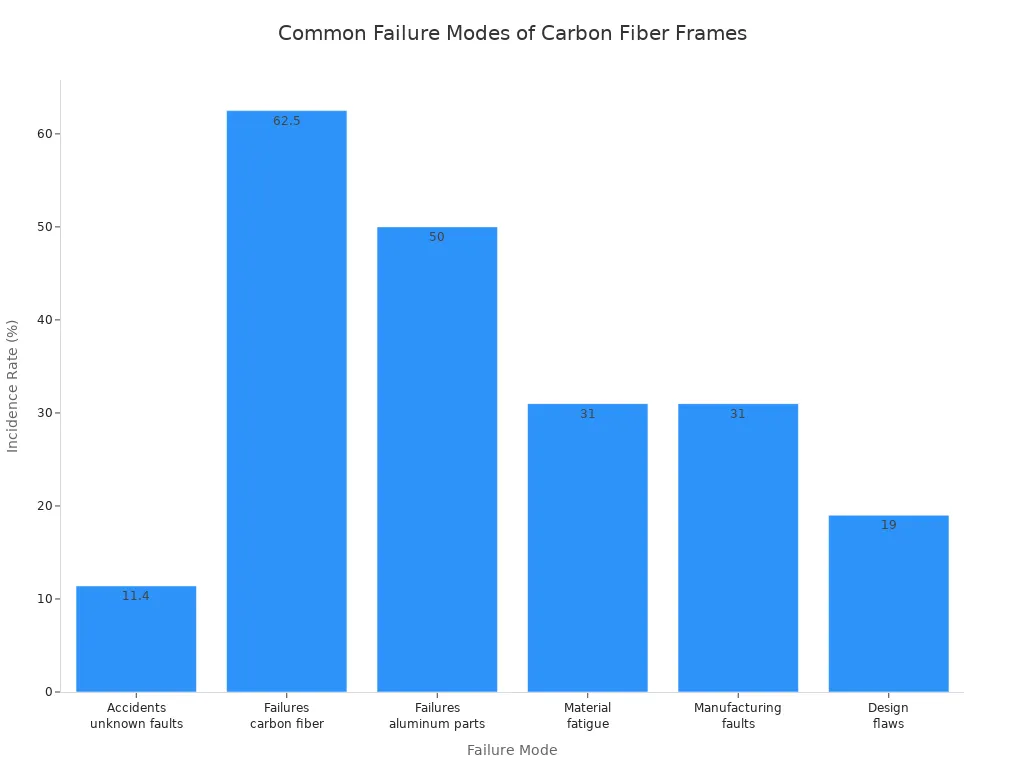
Note: Carbon fiber frames work really well but need careful checks and care to stay safe.
Steel
Steel frames have been used in bikes for a long time. Riders like steel because it gives a smooth and comfy ride. Steel bends a little, so it soaks up bumps and is good for long rides or rough roads.
Steel frames are heavier than aluminum and carbon fiber. But the extra weight is usually just a few pounds, so most riders do not mind. Steel’s tiny parts help spread out shaking, so the ride feels springy. Many people say steel frames feel “lively” when they ride.
Steel frames made from chromoly can weigh about the same as good aluminum frames.
Steel is strong and does not wear out fast, so it can last many years.
Aluminum frames are stiffer and lighter but feel rougher on bumpy roads.
Steel frames soak up bumps better, so they are more comfy.
Some tests show aluminum can last longer, but steel has a limit where it will not break if you do not go over it.
Not as many people buy steel frames now, but some still pick them for their classic feel and long life.
Tip: If you want a comfy and smooth ride, steel frames are great, especially for long trips or touring.
Frame Geometry
Geometry Factors
Frame geometry changes how a bike feels and works. Designers pick tube angles and lengths to control how the bike moves. The head tube angle helps with steering and balance. The seat tube angle affects how easy it is to pedal and how comfy you feel. Chainstay length changes how fast the bike turns and how steady it is. Where the bottom bracket sits changes how your muscles work and where you sit. These things change how weight is spread on the bike and how you ride.
Head tube angle helps with turning and balance.
Seat tube angle changes how easy it is to pedal and how comfy you are.
Chainstay length changes how fast the bike turns and how steady it feels.
Bottom bracket spot changes how your muscles work and where you sit.
Endurance road bikes use relaxed geometry. This puts you in a more upright spot. It helps your back, shoulders, and wrists feel better. Wider tires and special designs help make the ride smoother and easier to control. You can change some parts to fit your body and riding style.
Tip: Pick a geometry that fits your body and how you ride. A good fit helps you stay comfy and ride well for a long time.
Wheelbase and Head Angle
Wheelbase and head angle are very important. The wheelbase is the space between the front and back wheels. A longer wheelbase makes the bike steadier and smoother, even at high speeds or on bumpy roads. A short wheelbase makes the bike turn faster but can feel less steady.
The head angle changes how the bike turns. A slacker head angle (lower number) makes the bike steadier but slower to turn. A steeper head angle (higher number) makes the bike turn fast but can feel jumpy at high speeds. Designers mix these features to make bikes that work well in many places.
A slacker head angle and longer wheelbase are good for riders who want to feel safe and comfy on long rides. Steeper angles and shorter wheelbases are better for riders who want quick, sharp turns.
Rider Position
Rider position changes comfort and speed. Saddle height and setback change how your legs move and how much power you have. A higher saddle can make you more comfy and less tired. Moving the saddle back gives your legs more stretch, which can help you ride better and feel better.
Factor / Parameter | Effect on Comfort and Speed | Notes / Implications |
|---|---|---|
Saddle Height | Changes how your joints move, how you use oxygen, how much energy you use, and if you get hurt | The right saddle height helps you feel better and less tired; a low saddle can make you less comfy and more tired |
Saddle Setback | Changes how your legs stretch and how you pedal | Moving the saddle back gives your legs more stretch, which changes how you ride and feel |
Gender Differences | Body differences change the best saddle height | Old ways to fit bikes often work better for boys than girls |
Intensity and Fatigue | Your body moves differently when you ride hard or get tired | These changes affect how your joints move and how well you ride |
Training Level and Discipline | Different riders need different positions | You need to change your setup based on what kind of riding you do and how much you ride |
Bike Fitting Process | Changes the bike to fit your needs and goals | Helps you ride better, feel better, and control the bike |
Leaning back more can help you go faster by cutting wind. But it can also make you less comfy and harder to control the bike. The best position mixes speed with comfort and control. Bike fitting helps match the bike to your body. This lets your bones support you instead of just your muscles when you lean forward. It helps you handle the bike, stay steady, and feel good.
Aerodynamics
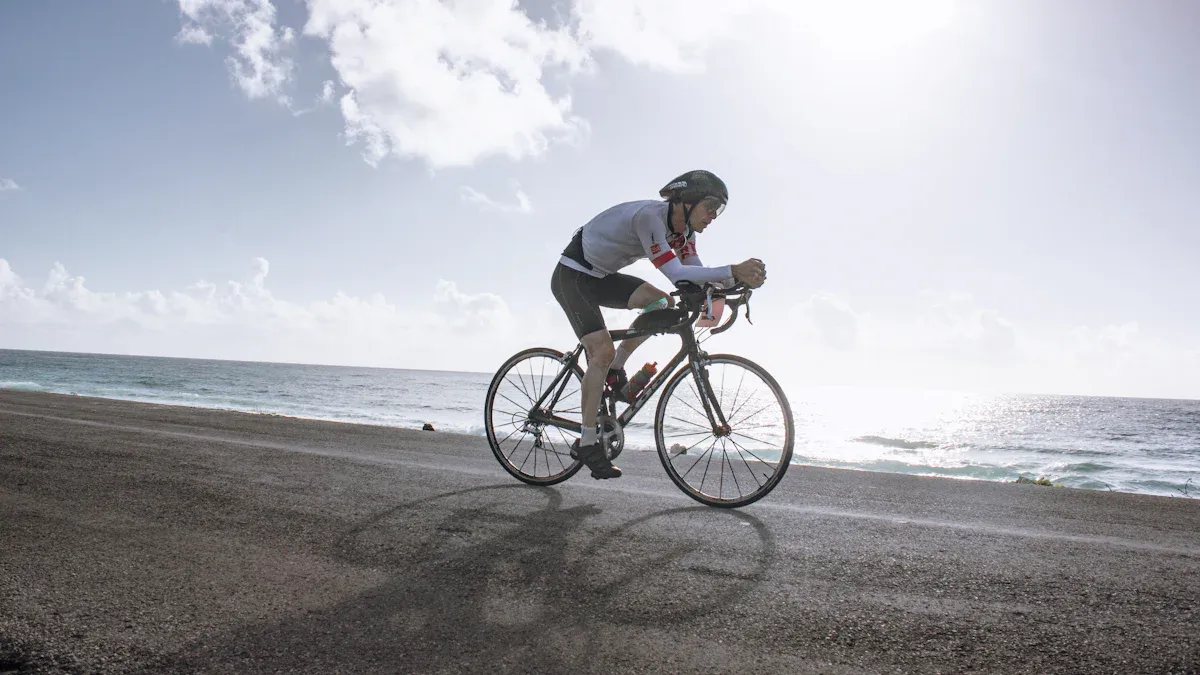
Frame Shape
Frame shape helps a bike move faster in the air. Engineers use special tube shapes like teardrop, truncated airfoils, and Kammtail. These shapes make air flow smoother around the frame. They also cut down on rough air. Wind tunnel tests show these shapes lower drag more than round tubes. Bike makers add handlebars, stems, and seatposts that fit together to help air move better.
Tip: Streamlined frame shapes help riders go faster by making it easier to push through the wind.
Drag Reduction
Aerodynamic frames use airfoil-shaped tubes to make the bike thinner. This helps reduce rough air. A Kammtail frame can lower drag by up to 20% compared to round tubes. Hidden cables and special cockpits can save 5-10 watts of power. These changes help riders go faster and use less energy. Most road cycling faces wind from the front. Engineers use computers and wind tunnels to test the best shapes for real rides.
Aerodynamic Feature | Drag Reduction Benefit |
|---|---|
Kammtail Frame Tubing | Up to 20% less drag |
Integrated Cockpit/Cables | 5-10 watts saved |
Airfoil Tube Profiles | Smoother airflow, less turbulence |
Aero vs. Comfort
Aerodynamic features help riders go faster, especially at high speeds. About 85% of a cyclist’s power fights air resistance, so aerodynamics matter for speed. Aero frames use stiffer shapes and deeper tubes. These changes can make bikes heavier and less comfy. Riders who sit upright may feel less steady and get pushed by wind more. Aero frames work best for racers who ride above 25 mph. Riders who want comfort or climb hills may like endurance bikes better.
They are usually heavier and not as flexible.
Upright riders may find handling harder and feel more wind.
All-rounder bikes mix comfort, stiffness, and aerodynamics.
Many bikes use features from both types.
Note: Riders should think about their goals. Aero frames are good for speed on flat roads. Endurance frames are better for comfort on long rides.
Stiffness and Compliance
Power Transfer
Stiffness in a bike frame helps riders use energy well. If the bottom bracket is stiff, it does not twist when you pedal hard. This sends more of your force straight to the back wheel. The rear triangle must also stay stiff so the chain moves power without wasting it. Designers make frames stiffer by using bigger bottom brackets and 30 mm cranksets. They also use special shapes in key spots. Carbon fiber frames use fibers placed in certain ways to make them stiff where needed. The table below shows how different frame parts help with power transfer:
Aspect of Frame Stiffness | Explanation | Impact on Power Transfer Efficiency |
|---|---|---|
Lateral stiffness at bottom bracket | Stops frame from twisting when you pedal | More force goes to the back wheel |
Rear triangle rigidity | Keeps the frame from bending as the chain moves force | Makes power delivery better |
Design features | Bigger bottom brackets, 30 mm cranksets, special shapes | Helps you speed up and climb better |
Carbon fiber lay-up configuration | Fibers placed for maximum stiffness | Makes frame stiff without adding weight |
Balance of stiffness and compliance | Too much stiffness feels rough; too little wastes power | Tries to mix speed and comfort |
Designers need to balance stiffness and compliance. If a frame is too stiff, the ride feels rough. If it is too soft, you lose energy.
Vibration Absorption
Vibration absorption helps riders feel comfy and less tired. When a bike stops vibrations from rough roads, muscles do not work as hard. This means less tiredness and pain, especially on long rides. Studies show that shaking can cause muscle pain, numb hands, and even injuries. Good vibration damping, like special handlebar inserts or foam, moves bad vibrations to safer levels. This keeps hands and arms from hurting and helps riders hold on tight.
Vibration damping lowers muscle tiredness.
It helps stop pain in hands, arms, and back.
Riders can go longer and feel better during and after rides.
Vertical Compliance
Vertical compliance means how much the bike bends up and down to soak up bumps. Most frames, especially classic diamond shapes, bend very little. The seatpost and tires do most of the work to smooth rough roads. A seatpost can bend much more than the frame, which helps comfort a lot. Tires with more air and wider shapes also soak up shocks. Frame features like dropped seatstays add a little more bend, but it is not much. Tests show almost all vertical compliance comes from the seatpost and tires, not the frame.
For a smoother ride on rough roads, riders should pick the right seatpost and tires instead of focusing on frame design.
Road Bike Frame Fit
A good fit helps riders get more from their bike. The right size and small changes make riding comfy and fast. Riders who focus on fit can avoid pain and ride longer.
Sizing
Picking the right frame size is very important. If the frame is too big or small, it can hurt and slow you down. Riders should look at standover height and reach. Standover height is the space between the top tube and you when you stand over the bike. Reach is how far it is from the saddle to the handlebars. These things change how you sit and move. A good fit helps you use your muscles well and keeps you strong.
Adjustments
After you pick the right size, you can make small changes to feel better and go faster. Riders often change these things:
Saddle height: Set so your knee bends a little at the bottom of the pedal stroke. This helps you pedal strong and feel good.
Handlebar position (reach and height): Changed to stop pain in your back, neck, and arms. It also helps you sit better and cut wind.
Cleat position: Put so your feet, ankles, and knees stay straight. This lowers the chance of getting hurt and helps you pedal.
Small changes and testing: Riders make tiny changes and try them out on rides to find what works best.
Handlebar height and frame length change how your muscles work. Lower handlebars help you cut wind but can cause pain. A longer frame can stretch you out, which may help you go faster but can hurt comfort.
Common Fit Issues
Many riders have fit problems that make riding less comfy and slow them down. The table below shows some common problems, why they happen, and how they affect riding.
Fit Issue | Prevalence (%) | Common Causes | Impact on Performance and Comfort |
|---|---|---|---|
Lower back pain | Bent posture for a long time, tough riding position, saddle tilt, handlebar height and reach | Makes muscles tired, hurts joints; less comfort and power | |
Numbness in hands | 21.5 | Nerves squeezed by low handlebars, long reach, saddle tilt | Tingling, no feeling; hard to grip and control |
Knee pain | 19.5 | Knee joint stress, saddle height and cleat mistakes | Hurts and makes pedaling hard and tiring |
Neck pain | 14 | Long reach, bad handlebar height causing tired muscles and nerves | Less comfort and endurance, can cause headaches |
Numbness in feet | 11.5 | Nerves squeezed from bad bike fit | No feeling in feet, hurts pedaling comfort |
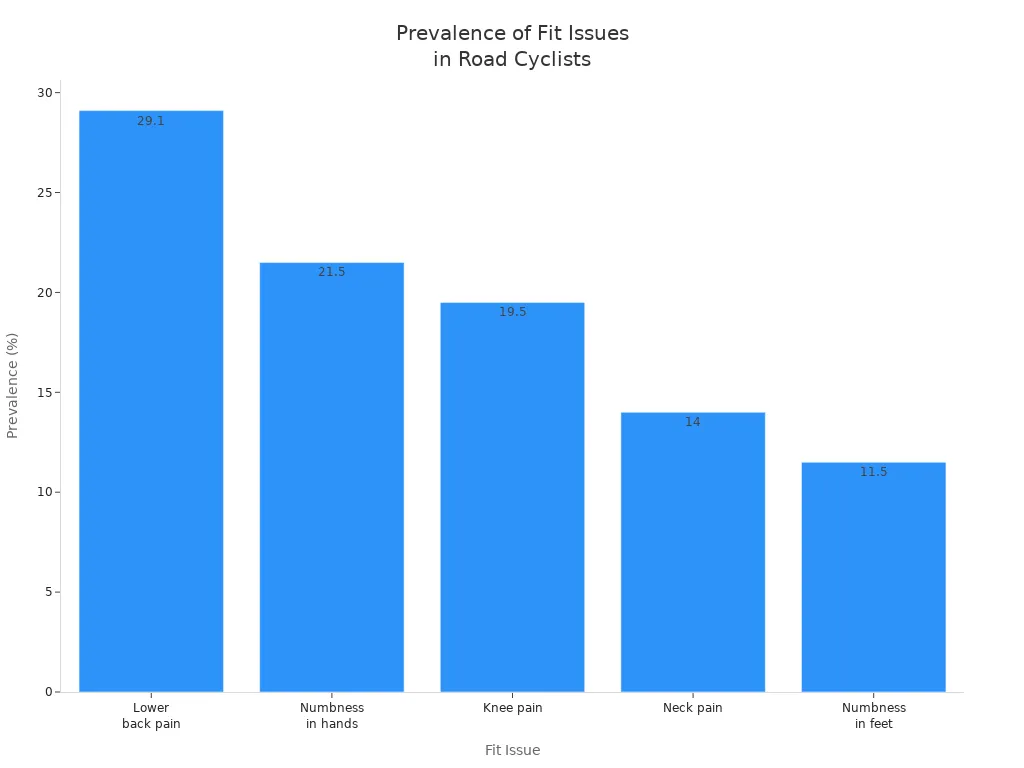
A good fit helps riders avoid these problems. Changing the bike to match your body and style can make riding more comfy, lower injury risk, and help you go faster and farther.
Choosing Your Frame
Riding Style
Every rider wants something different. The best road bike frame depends on where and how you ride. Riders should think about these things:
Riding style helps you pick the right frame. Road bikes are best for smooth roads. Gravel or hybrid bikes work on mixed paths. Mountain bikes are for rough trails.
Terrain is important. Smooth roads need one kind of frame. Gravel or hills need another.
Fit and comfort are most important. The right frame size, based on your height and inseam, stops pain and helps you ride better.
Budget and features matter too. Carbon fiber costs more but is lighter and comfier. Aluminum is cheaper and light but can feel harder.
Frame geometry changes how you sit. Sport geometry lets you sit up for long rides. Performance geometry puts you lower for more speed.
Tip: Pick a frame that matches your main goal, like racing, fitness, or long trips.
Test Riding
Test rides help you feel the difference between frames. A test ride shows how the bike fits, handles, and takes bumps. You can try hills or flat roads to see how the bike works. Riding the bike helps you find comfort or fit problems that you cannot see in the specs.
Test rides help you check comfort, size, and handling.
Riding like you would in real life helps you choose.
Test rides help you feel sure about your choice.
Some expensive bikes may not be available to test.
Note: Test rides are one of the best ways to see if a road bike frame is right for you.
Comfort vs. Speed
Riders have to choose between comfort and speed when picking a frame. The table below shows the main things to think about:
Consideration | Description | Impact on Comfort and Speed |
|---|---|---|
Bike Type | Performance vs Endurance | Performance bikes are fast but less comfy. Endurance bikes are smoother for long rides. |
Frame Geometry | Aggressive vs Relaxed | Aggressive geometry boosts speed. Relaxed geometry improves comfort. |
Frame Compliance | Vibration absorption | More compliance means a smoother ride. |
Frame Material | Titanium, aluminum, carbon fiber, steel | Each material changes weight, comfort, and durability. |
Tire Width | Narrow vs Wider | Wider tires add comfort and can help with speed. |
Versatility | Handling different terrains | Endurance bikes handle more surfaces without losing much speed. |
You should decide what is most important to you. Some riders want the fastest bike. Others want comfort for long rides. The best road bike frame gives you the right mix of both.
A road bike frame feels good and goes fast because of its material, shape, fit, and tire width. New research says titanium frames are strong and comfy. Wider tires help make rides smoother and can also make you faster. Riders should pick the right size, get help from a bike expert, and choose a bike that fits how they like to ride. The table below shows the main points:
Aspect | Key Takeaways |
|---|---|
Frame Materials | Aluminum and carbon fiber are light and fast. Steel and titanium are strong and comfy. |
Tire Width | Wider tires make rides smoother and help you roll easier. |
Bike Types | Competition bikes are made for speed. Endurance bikes are made for comfort. |
Riders can find what works best by trying out different bikes and asking experts for advice. Try different choices to find the best road bike frame for you!
FAQ
What frame material offers the best balance of comfort and speed?
Carbon fiber is light and stiff. It also soaks up bumps well. Aluminum is good if you want to save money and weight. Steel gives a smooth ride but is heavier. Each material works best for different riders.
How does frame geometry affect rider comfort?
Frame geometry changes how you sit and move on the bike. A relaxed geometry makes long rides more comfy. Aggressive geometry helps you go faster but can hurt after a while.
Can wider tires improve comfort on a road bike?
Wider tires soak up more bumps and shaking. Riders feel less roughness on bumpy roads. Many endurance bikes use wider tires for a smoother ride.
Why is bike fit important for speed and comfort?
A good bike fit helps you use your muscles well. The right fit lowers pain and tiredness. You can ride better and enjoy longer trips.
Should a beginner choose an aero frame or an endurance frame?
Endurance frames are better for beginners. They are more comfy and easier to control. Aero frames are made for speed and can feel less steady for new riders.
See Also
How To Find The Perfect Bike Frame For You
The Importance Of Selecting Proper Bike Frame Geometry
How Carbon Fiber Enhances Smooth And Lightweight Rides
